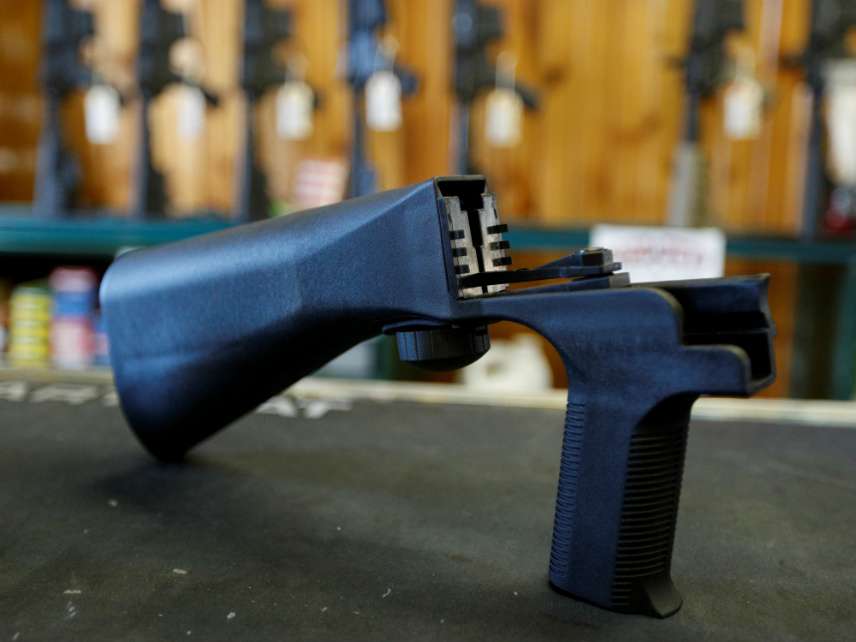ATF Flips on Bump Stock Ban, Some Gun Rights Groups Are Mad
Under Obama the ATF admitted that Congress denied it authority to ban bump-fire stocks on AR-15s, but now the ban seems imminent.

For nearly a decade, on precisely 10 different occasions, the Bureau of Alcohol, Tobacco, Firearms, and Explosives (ATF) concluded that so-called bump-fire stocks on AR-15s and similar rifles are legal under federal law. Bump-fire stocks use the gun's recoil to increase the rate of fire.
But then came the October 2017 mass shooting of concert attendees in Las Vegas, where police said the shooter possessed bump fire stocks. Within weeks, the ATF abruptly reversed itself, with an endorsement from President Donald Trump and Attorney General Jeff Sessions earlier this year.
Two gun rights groups today filed documents accusing the ATF of acting unlawfully by concealing evidence, exceeding authority granted by Congress, and ignoring the Second Amendment. Today is the last day to file comments on the ATF's proposed ban, which will take effect later this year—assuming it's not withdrawn or prevented from taking effect by a court challenge.
ATF's proposed ban, published March 29, would treat bump fire stocks as machine guns regulated under the National Firearms Act of 1934. "Current possessors of these devices would be required to surrender them, destroy them, or otherwise render them permanently inoperable upon the effective date of the final rule," the ATF's announcement says.
Trump endorsed the federal ban—bump fire stocks are already illegal in California and some other states—in February. "We can do that with an executive order," Trump said at the time. "I'm going to write the bump stock, essentially, write it out. So you won't have to worry about bump stock[s]. Shortly that will be gone." The National Rifle Association's Wayne LaPierre and Chris Cox endorsed Trump's position, saying in a statement that ATF should "immediately review whether these devices comply with federal law."
Today's lengthy filing by the two Second Amendment groups, the Firearms Policy Coalition and Firearms Policy Foundation, is likely to prove embarrassing to the ATF. It lays out a convincing argument that the agency had investigated bump-fire stocks in great detail, and, in sworn testimony and pleadings in federal district court, concluded that they were perfectly legal under federal law.
During the Obama administration, an era not known for its aggressive pro-gun advocacy, the ATF even went beyond that statement—and concluded that Congress had denied it the authority to classify bump-fire stocks as machine guns. A 2013 letter from the ATF to Rep. Ed Perlmutter (D-Colo.) said flatly that "ATF does not have the authority to restrict their lawful possession, use, or transfer." Anti-gun Democrats have echoed this, with Sen. Dianne Feinstein saying on Twitter last fall: "The ATF lacks authority under the law to ban bump-fire stocks. Period. Legislation is the only answer and Congress shouldn't pass the buck."
The filing by the Firearms Policy Coalition and Firearms Policy Foundation points out videos, some available on YouTube, that show how to fire an unmodified AR-15 faster and more accurately than a bump-fire stocks. One technique shows how to achieve "the same result" with a simple rubber band, which is apparently not banned by the ATF's proposal.
Finally, it argues that there is no evidence the Las Vegas shooter used a firearm outfitted with a bump fire stock. The groups acknowledge that the Las Vegas police's preliminary report, released in January, indicates that some weapons found in the Mandalay Bay hotel room were outfitted with devices similar to bump-fire stocks. But, they say, the report never says that those particular guns were used during the crime. (The two groups filed an expedited Freedom of Information Act request with the ATF and FBI on this point, but report that, as of today, neither agency has confirmed the use of a bump-fire stock in the commission of any crime. Both agencies are involved in the Las Vegas investigation.)
"Because of the federal rulemaking process [the Administrative Procedure Act] and the possibility of litigation with procedural claims, we wanted to provide a robust comment in opposition to the ban that was supported by evidence," says Firearms Policy Coalition president Brandon Combs. "What's unique about this issue is how clear, I think, the statutes are."
If Trump wishes to ban bump-fire stocks, the path seems straightforward: Ask Congress to do it. As Reason's Jacob Sullum wrote earlier this year, "the route Trump has chosen is not just indirect and uncertain; it is dishonest and unprincipled." That criticism also applies to Sessions, who presents himself as a conservative committed to defending the Constitution and the separation of powers.
Rep. Thomas Massie, the Kentucky Republican who leads the congressional Second Amendment Caucus, told Reason last fall: "It is the height of legislative malpractice to ask the executive branch to legislate… It will come back to bite us, and it erodes the system of government that the Founding Fathers intended to set up."
You can file comments on the ATF's proposed bump-fire ban, docket ATF-2018-0002, using Regulations.gov until midnight ET tonight.




Show Comments (50)